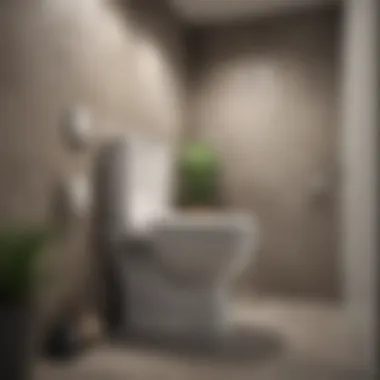Effective Strategies to Prevent Toilet Clogs


Intro
In this guide, we will explore various aspects contributing to toilet clogs and how homeowners can act to prevent these inconveniences. This overview serves as a foundation for the detailed strategies that follow, helping readers grasp the importance of proper toilet care and maintenance.
Understanding Toilet Mechanism
Understanding the toilet mechanism is vital to preventing clogs effectively. Toilets have specific components that work together to ensure proper waste removal. By knowing how these elements function, homeowners can take proactive measures to avoid common issues associated with toilets. This knowledge also aids in recognizing signs of trouble before they escalate into more serious plumbing problems.
Basic Components of a Toilet
A toilet comprises several basic components that contribute to its operation. Each part plays a crucial role in how effectively the toilet flushes waste. The most important components include:
- Tank: This holds water that is necessary for flushing. It refills after each flush to prepare for the next.
- Bowl: Where waste collects. Its design allows gravity to assist in the flushing process.
- Flush Valve: This opens at the time of flushing, releasing water from the tank to the bowl.
- Float: This mechanism helps control the water level in the tank. It rises and falls to maintain the right amount of water.
- Flapper: It seals the flush valve until the flush is initiated. A malfunctioning flapper can cause water wastage.
Understanding these elements helps in recognizing potential issues before they cause clogs. For instance, if the flapper does not seal correctly, it may lead to improper flushing and potential blockages.
How Toilets Flush
The flushing process is critical in the function of a toilet. When the handle is pressed, the following occurs:
- The flush handle lifts the flapper, allowing water from the tank to rush into the bowl.
- As the bowl fills, the water creates a siphoning effect.
- This siphon action pulls the waste down the drain.
- The waste exits the bowl through the trap, which prevents sewer gases from entering the bathroom.
Understanding this process highlights how important it is for the components to work harmoniously. Disruptions in any part can lead to inefficient flushing and subsequent clogs.
Common Issues Related to Flushing
Despite their simplicity, toilets can experience common issues that contribute to flushing problems. These include:
- Weak Flush: This may result from low water levels or a clogged refill tube.
- Phantom Flushes: Caused by a leaky flapper, causing the tank to refill without any user action.
- Double Flushing: If the flush isn’t powerful enough, waste may not clear in a single flush, leading to the need for a second attempt.
- Clogs: Arising from excessive use of waste or foreign materials not intended for the toilet.
Recognizing these issues can save money and time by prompting immediate action before the situation worsens. Thus, having a grasp of how toilets function lays the groundwork for effective strategies to prevent clogs.
Identifying Causes of Toilet Clogs
Understanding the causes behind toilet clogs is crucial for any homeowner. Identifying these factors can lead to effective prevention methods and ensure optimal toilet functionality. Many issues may contribute to a clogged toilet, and knowing these can save time and avoid disruptions in daily life.


Inappropriate Waste Disposal
Toilet systems are designed to handle human waste and toilet paper. Flushing inappropriate items is a primary cause of clogs. Common examples include feminine hygiene products, paper towels, and even food waste. Flushing these items can quickly lead to blockage.
It is important to educate all household members about proper disposal practices. Having a small trash bin nearby can encourage the disposal of non-flushable items instead. This prevents the unnecessary stress of dealing with clogs and prolongs the life of the plumbing.
Excessive Toilet Paper Use
Using too much toilet paper is another frequent cause for clogs. Many individuals may not realize how even a small adjustment in their usage habits can make a significant difference. It is advisable to limit the amount of toilet paper used in each flush.
If a single roll of toilet paper is repeatedly used in large amounts, this can form a dense mass that blocks the toilet. When multiple people share one bathroom, usage can increase dramatically. Encouraging lighter usage can provide an immediate boost to toilet efficiency.
Foreign Objects in the Toilet
Often, foreign objects accidentally find their way into toilets. Items such as toys, toothbrushes, or personal items can create immediate obstruction. These objects can result in serious blockages, and retrieving them can often require professional help.
It is wise to ensure that young children understand the importance of keeping the toilet as a waste disposal system only. Therefore, supervision is needed, especially when young families are involved.
Aging and Damaged Plumbing
Plumbing systems are not immune to wear and tear. Aging pipes can develop rust, mineral deposits, or cracks. These conditions significantly increase the risk of blockages. If plumbing is already compromised, even small flushing loads can lead to major problems.
Regular inspections of your plumbing system are highly recommended. Look for early signs of deterioration, and address issues as soon as they arise. Homeowners should consider having a plumbing professional conduct routine evaluations to avoid catastrophic failures.
Identifying these causes can greatly minimize the risk of future clogs. The proactive measures you take can ensure that your toilet runs smoothly, contributing to a hassle-free household.
Preventive Strategies for Clog Prevention
Taking proactive measures to prevent toilet clogs is essential for homeowners. Such strategies not only ensure the functionality of the toilet but also save money on potential repairs. The significance of these strategies lies in the reduction of inconvenient plumbing issues and the maintenance of hygiene in the household. Proper management and care of toilet use may significantly extend the life of plumbing systems.
Educating Household Members
Communication within the household is one of the most vital steps in preventing toilet clogs. Ensuring that every member knows what can and cannot be flushed is crucial. This includes avoiding disposal of items like wipes, feminine hygiene products, and other non-flushable materials. A simple discussion can lead to proper understanding and behavior change. Consider creating a visual guide placed prominently near the toilet that shows acceptable and unacceptable items for flushing. This guaranteed awareness can greatly mitigate the risk of clogs.
Proper Waste Disposal Practices
Establishing correct waste disposal habits is another significant component in preventing toilet clogs. Whenever possible, use trash bins for disposal of waste that shouldn’t be flushed. Items such as dental floss, cotton swabs, and food debris should be disposed of properly. Educating children about these practices can help instill good habits early. Additionally, choosing biodegradable waste bags for items like dog waste can also ease the burden on plumbing systems. Following these recommendations leads to both a clean toilet and a healthy plumbing system.


Limiting Toilet Paper Usage
While toilet paper is designed to be flushed, excessive amounts can easily lead to blockages. It is wise to indicate a limit to how much toilet paper is used in one go. Consider using less paper or switching to thinner varieties. If a person finds that they need to use large amounts frequently, they should consider seeking alternatives such as bidets, which can minimize paper use and improve hygiene.
Regular Inspection of Plumbing
Performing regular inspections of the plumbing system can catch small issues before they escalate into significant blockages. Homeowners should check visible pipes, joints, and connections for leaks or wear. Observing any slow drainage or unusual noises can indicate a plumbing problem brewing. Scheduling periodic professional plumbing check-ups can also be advisable. Such diligence can identify and mitigate issues like tree root invasion or buildup in the pipes that could result in severe clogs.
Regular maintenance and preventive strategies can save time and money in the long run, promoting a healthier and functioning plumbing system.
Implementing these preventive strategies ensures a smoother, clog-free toilet experience in homes. Recognizing the importance of proper education, waste disposal, limited usage of toilet paper, and regular plumbing inspections is key to maintaining an efficient toilet system.
Routine Maintenance for Optimal Performance
Routine maintenance is essential for ensuring the long-term functionality and efficiency of toilets. Regular upkeep prevents clogs, reduces the risk of costly repairs, and contributes to a more pleasant bathroom experience. By proactively maintaining a toilet, homeowners can ensure that it operates as intended, thereby minimizing issues that may arise from neglect.
Cleaning the Toilet Regularly
Cleaning the toilet is a fundamental yet often overlooked aspect of maintenance. Regular cleaning reduces the buildup of grime, bacteria, and mineral deposits that can impede flushing capability. It is advisable to clean the toilet at least once a week using a suitable toilet bowl cleaner. Look for products that effectively dissolve hard water stains and disinfects the bowl.
To clean:
- Apply cleaner in the bowl and let it sit for a few minutes.
- Scrub with a toilet brush, paying attention to the under rim where germs often accumulate.
- Flush to remove the cleaner.
In addition to the bowl, don’t forget to clean the external parts of the toilet, including the tank and handle. This not only enhances hygiene but also prolongs the lifespan of the toilet. Cleaning promotes an overall healthier environment, which is particularly important in households with children or elderly members.
Flushing with Care
How one flushes the toilet can have a direct impact on its performance. Flushing with care means understanding the right practices to avoid unnecessary stress on the plumbing system. Here are a few key points to consider:
- Only flush toilet paper and human waste. Other items, like wet wipes, cotton swabs, or feminine hygiene products, can lead to clogs.
- Avoid multiple flushes for large waste. Instead, ensure everything is in the bowl before you flush once. Multiple flushes can result in partial flushes, causing obstructions.
- Flush when necessary. Consistent flushing after each use may seem hygienic. However, it can lead to higher water consumption and stress the plumbing system when combined with inappropriate waste.
Proper flushing techniques are essential for maintaining toilet efficiency and preventing clogs. By being mindful of what goes down the toilet and how it is flushed, one can significantly reduce the risk of obstructed pipes.
Utilizing Plumbing Tools


Utilizing plumbing tools is a critical aspect of maintaining a functional and efficient toilet system. Homeowners are often tempted to rely solely on store-bought chemicals or quick fixes. However, having the right tools on hand can empower individuals to tackle clogs effectively, reducing the likelihood of serious plumbing issues. More importantly, these tools can provide immediate solutions and save money on professional services when minor issues arise.
Proper implementation of plumbing tools offers various benefits. First, they allow for a more thorough inspection of the plumbing system. Tools such as plungers and drain snakes can reach areas that either standard toilet flushing or chemical solutions cannot access. This can lead to a better understanding of the overall condition of plumbing and aid in spotting potential problems before they become greater issues.
Another consideration is the convenience that these tools provide. Instead of being caught off-guard by a clog, a homeowner equipped with basic plumbing tools can quickly respond, preventing water build-up and potential damage to surrounding areas. Moreover, it contributes to lesser reliance on commercial services, which can often lead to increased costs over time.
In summary, using appropriate plumbing tools fosters a proactive approach to toilet maintenance and helps ensure smooth operations. Below we will discuss two essential tools that serve as the first line of defense against toilet clogs.
When to Seek Professional Help
Addressing toilet clogs may seem straightforward, but there are moments when calling a professional is not just wise but essential. Handling complicated or persistent clogging issues can often lead to unnecessary stress and may cause further damage if not addressed properly. Recognizing the correct time to seek expert advice can save you both time and expense.
Signs of Serious Blockage
Several warning signals indicate a serious blockage in your toilet. Being attentive to these signs can help you determine if it is time to call in a professional. Here are some critical indicators:
- Frequent or Persistent Clogs: If you regularly find yourself unclogging the toilet, this suggests an underlying issue that may not be resolved by simple home remedies.
- Multiple Fixtures Affected: If multiple drains in your home are backing up or draining slowly, this could indicate a main line blockage. Toilets, sinks, and bathtubs sharing the same line can be affected simultaneously.
- Unpleasant Odors: Persistent foul smells coming from your toilet or drain can suggest a blockage that may be tainted with harmful bacteria.
- Water Overflowing: If your toilet is constantly overflowing or the water level is unusually high after a flush–this can signify a backup in the pipes.
- Gurgling Sounds: Unusual noises from the toilet or pipes, like gurgling, often signal trapped air from a blockage.
If you observe one or more of these signs, do not hesitate to reach out to a licensed plumber for a thorough examination. Ignoring these warning signs could lead to catastrophic plumbing emergencies that require extensive repairs.
Choosing a Licensed Plumber
Selecting the right professional is crucial in ensuring that your plumbing issues are correctly resolved. Here are several factors to consider when choosing a licensed plumber:
- Verify Licensing and Insurance: Always confirm that the plumber holds a valid license and insurance. This protects you from any liabilities in case of accidents during the job.
- Seek Recommendations: Word of mouth can be powerful. Ask friends or family for trusted plumber recommendations based on their experiences.
- Read Reviews: Online reviews can provide insight into the plumber’s reliability and quality of work. Websites like reddit.com or local business directories can be helpful to gather opinions.
- Get Estimates: Do not settle for the first plumber you contact. Seek estimates from multiple professionals to compare costs and services.
- Ask About Experience: Determine if the plumber has dealt with similar issues before. An experienced plumber will be more equipped to handle unique problems.
Understanding when to consult a plumbing professional and how to select the right one is an essential part of toilet maintenance. By recognizing the signs of serious blockage and knowing how to find a reputable plumber, homeowners can prevent minor issues from escalating into major expenses.
Closure
Understanding how to prevent toilet clogs is essential for maintaining smooth operations in any household. Toilet clogs can cause inconvenience, lead to plumbing emergencies, and incur costly repairs. In this article, we discussed various practices and strategies that can help avert such issues.
Recap of Effective Practices
- Educating Household Members: Knowledge is power. All individuals who use the toilet should understand what can and cannot be flushed. Educating them ensures responsible use.
- Proper Waste Disposal Practices: As mentioned, disposing of appropriate materials in the toilet is crucial. This includes refraining from flushing items like wipes, feminine hygiene products, and paper towels, as these do not break down easily.
- Limiting Toilet Paper Usage: It is wise to limit the amount of toilet paper used in each visit. Excessive use can quickly lead to clogs. A good practice is to encourage a few squares at a time.
- Routine Maintenance: Regular cleaning and inspections of plumbing can reveal issues before they escalate, keeping toilets functioning properly.
- Utilizing Plumbing Tools: Having a plunger and drain snake can save you a lot of trouble. These tools are effective for immediate response to clogs.
"Prevention is always better than cure." Engaging in these practices can undoubtedly reduce the chances of encountering toilet clogs.
Encouragement for Proactive Maintenance
Maintaining proactive measures is vital in ensuring the longevity of your plumbing. Regular maintenance not only prevents clogs but also enhances the overall functionality of your toilet. Homeowners should schedule inspections at least once a year. This can uncover issues like minor leaks or build-up that often go unnoticed.
Consider creating a plan for routine cleaning. This reinforces habits among family members to treat the toilet with care. Investing time in understanding the toilet's mechanism will empower users to recognize early signs of trouble.







